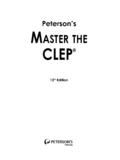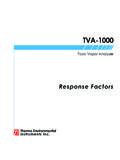Transcription of Positive Psychology Progress
1 Positive Psychology ProgressEmpirical Validation of InterventionsMartin E. P. Seligman and Tracy A. SteenUniversity of PennsylvaniaNansook ParkUniversity of Rhode IslandChristopher PetersonUniversity of MichiganPositive Psychology has flourished in the last 5 years. Theauthors review recent developments in the field, includingbooks, meetings, courses, and conferences. They also dis-cuss the newly created classification of character strengthsand virtues, a Positive complement to the various editionsof theDiagnostic and Statistical Manual of Mental Disor-ders(e. g., American Psychiatric Association, 1994), andpresent some cross-cultural findings that suggest a surpris-ing ubiquity of strengths and virtues.
2 Finally, the authorsfocus on psychological interventions that increase individ-ual happiness. In a 6-group, random-assignment, placebo-controlled Internet study, the authors tested 5 purportedhappiness interventions and 1 plausible control found that 3 of the interventions lastingly increasedhappiness and decreased depressive symptoms. Positiveinterventions can supplement traditional interventions thatrelieve suffering and may someday be the practical legacyof Positive : Positive Psychology , happiness, characterstrengths, interventionsFive years have passed since theAmerican Psychol-ogistdevoted its millennial issue to the emergingscience of Positive Psychology : the study of positiveemotion, Positive character, and Positive institutions (Se-ligman & Csikszentmihalyi, 2000).
3 Drawing on methodseffectively used to advance the science of mental disorders, Positive psychologists have been studying mental healthand well-being. Building on pioneering work by Rogers(1951), Maslow (1954, 1962), Jahoda (1958), Erikson(1963, 1982), Vaillant (1977), Deci and Ryan (1985), andRyff and Singer (1996) among many others positivepsychologists have enhanced our understanding of how,why, and under what conditions Positive emotions, positivecharacter, and the institutions that enable them flourish( , Cameron, Dutton, & Quinn, 2003; Easterbrook, 2003;Gardner, Csikszentmihalyi, & Damon, 2001; Kahneman,Diener, & Schwarz, 1999; Murray, 2003; Vaillant, 2000).
4 Positive psychologists do not claim to have inventedthe good life or to have ushered in its scientific study, butthe value of the overarching termpositive psychologyliesin its uniting of what had been scattered and disparate linesof theory and research about what makes life most worthliving (Peterson & Park, 2003). As the basic science con-tinues, other lines of work are moving into the realm ofapplication (Linley & Joseph, 2004). Can psychologiststake what they have learned about the science and practiceof treating mental illness and use it to create a practice ofmaking people lastingly happier? That is, can they createan evidence-based practice of Positive Psychology ?
5 In this article, we first review the recent growth withinpositive Psychology . Next, we describe basic research thatbears on whether people can become lastingly happier, andthen we present the results of our own happiness interven-tions that we rigorously tested with a randomized, placebo-controlled ReportPositive Psychology is an umbrella term for the study ofpositive emotions, Positive character traits, and enablinginstitutions. Research findings from Positive psychologyare intended to supplement, not remotely to replace, what isknown about human suffering, weakness, and disorder. Theintent is to have a more complete and balanced scientificunderstanding of the human experience the peaks, thevalleys, and everything in between.
6 We believe that acomplete science and a complete practice of psychologyshould include an understanding of suffering and happi-ness, as well as their interaction, and validated interven-tions that both relieve suffering and increase happiness two separable s E. P. Seligman was president of APA in 1998. Thisarticle is based in part on his presidential address, delivered in Boston atAPA s 107th Annual Convention on August 21, 1999. This article updatesthe Progress of research on Positive Psychology in a follow-up to theJanuary 2000 special issue of theAmerican s E. P. Seligman and Tracy A. Steen, PositivePsychology Center, University of Pennsylvania; Nansook Park, Depart-ment of Psychology , University of Rhode Island; Christopher Peterson,Department of Psychology , University of research was supported by the Annenberg/Sunnylands TrustFoundation, by Atlantic Philanthropies, by the John Marks TempletonFoundation, and by National Institute of Mental Health Grant concerning this article should be addressed toMartin E.
7 P. Seligman, Positive Psychology Center, University ofPennsylvania, 3701 Market Street, Philadelphia, PA 19104 or toChristopher Peterson, Department of Psychology , University of Mich-igan, 525 East University, Ann Arbor, MI 48109-1109. or August 2005 American PsychologistCopyright 2005 by the American Psychological Association 0003-066X/05/$ 60, No. 5, 410 421 DOI: the last five years, aside from a special issue and aspecial section of theAmerican Psychologist(January 2000and January 2001, respectively), literally hundreds of arti-cles have appeared in the scholarly and popular press on thetopics of Positive Psychology .
8 Books have begun to appear,for example,The Handbook of Positive Psychology (Sny-der & Lopez, 2002),Authentic Happiness(Seligman,2002),A Psychology of Human Strengths(Aspinwall &Staudinger, 2003),Flourishing(Keyes & Haidt, 2003), Positive Psychological Assessment: A Handbook of Modelsand Measures(Lopez & Snyder, 2004), Positive Psychol-ogy in Practice(Linley & Joseph, 2004), andHandbook ofMethods in Positive Psychology (Ong & van Dulmen, inpress). These volumes summarize the empirical findingsand the methods used in the want to highlight our ownCharacter Strengthsand Virtues: A Handbook and Classification(CSV; Peter-son & Seligman, 2004).
9 TheCSVrepresents the mostambitious project self-consciously undertaken from theperspective of Positive Psychology , and we intend it to dofor psychological well-being what theDiagnostic and Sta-tistical Manual of Mental Disorders(DSM) of the Ameri-can Psychiatric Association (1994) does for the psycholog-ical disorders that disable human beings. TheCSVdescribes and classifies strengths and virtues that enablehuman thriving. Although we were respectful of theDSM,we attempted to avoid some of its problems by makingclear why some entries were included in theCSVand othersexcluded, by regarding Positive traits as individual differ-ences that exist in degrees rather than as all-or-nothingcategories, and by developing reliable and valid assessmentstrategies (questionnaires, surveys, interviews, and infor-mant reports; Peterson, Park, & Seligman, 2005a).
10 The general scheme of theCSVrelies on six overar-ching virtues that almost every culture across the worldendorses: wisdom, courage, humanity, justice, temperance,and transcendence (Dahlsgaard, Peterson, & Seligman, inpress). Under each virtue, we identified particular strengthsthat met the following criteria: ubiquity is widely recognized across cultures fulfilling contributes to individual fulfillment, sat-isfaction, and happiness broadly construed morally valued is valued in its own right and notas a means to an end does not diminish others elevates others who wit-ness it, producing admiration, not jealousy nonfelicitous opposite has obvious antonyms thatare negative traitlike is an individual difference with demon-strable generality and stability measurable has been successfully measured byresearchers as an individual difference distinctiveness is not redundant (conceptually orempirically)






